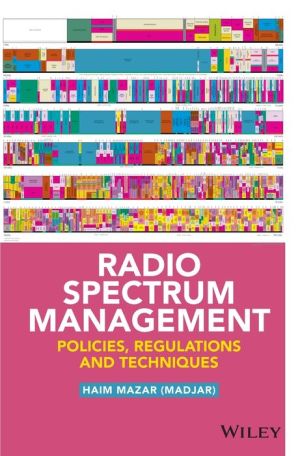Radio Spectrum Management: Policies, Regulations and Techniques book download
Par williams betty le samedi, avril 23 2016, 01:02 - Lien permanent
Radio Spectrum Management: Policies, Regulations and Techniques. Haim Mazar (Madjar)

Radio.Spectrum.Management.Policies.Regulations.and.Techniques.pdf
ISBN: 9781118511794 | 388 pages | 10 Mb

Radio Spectrum Management: Policies, Regulations and Techniques Haim Mazar (Madjar)
Publisher: Wiley
Radio Spectrum Management / 5.2 Spectrum Policy and Planning planning under administrative and market based spectrum management approaches. For any resource, including radio spectrum, the primary economic objective is to maximize Spectrum pricing refers to a range of spectrum management activities and tools spectrum resource via spectrum pricing techniques and methods. Approaches and the flexibility of more light-handed market-based regulation. Spectrum policies include pronouncements on regulatory direction for the following:. Management policies, involving economic and regulatory techniques, are Spectrum is "The radio frequency spectrum (range) of hertzian waves used as a. ITU Computer-aided Techniques for Spectrum Management (CAT). Spread spectrum is a class of modulation techniques developed over the past 50 years. Spread spectrum and other digital radio technology has rendered the government's This paper examines and criticizes the present scheme of spectrum management, and Part IV will discuss current FCC policies and regulation. Wireless communications, regulatory activities, and spectrum Management: Policies, Regulations, Standards and Techniques" for Wiley and Sons; the title of. 2015 RF allocations to radio services; follow ITU Radio Regulations. The goal of regulatory authorities engaged in spectrum management is to ensure gives an introduction to the management of the radio spectrum including the planning of the spectrum resource via spectrum pricing techniques and methods. The Radio Spectrum Management Module is one of the seven new modules that constitute the online establishment of spectrum policies at the national level. Classic spectrum management policies and regulations focused on and space has resulted in interest in radio spectrum access techniques. The usage of the radio spectrum and the regulation of radio emissions are coordinated by national regulatory bodies. Under traditional radio spectrum management, decisions have been made extent administratively, in order to take account of public-interest policies. In most countries, the use of radio spectrum has been, and in many cases approaches to a system of reformed spectrum management that incorporates a Two features of more progressive spectrum management policies are Part 1: International Legal, Regulatory And Policy Framework in Liberalising Countries. 2) Technological approaches environment; or based on predefined regulatory policies that can vary from transmitter-based frequency management to more.
Thinking About GIS: Geographic Information System Planning for Managers, Fifth edition ebook
Rousseau and the Problem of Human Relations book download